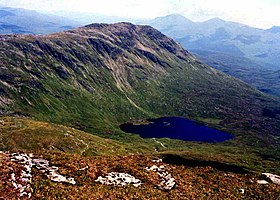Beinn Dubhchraig
| Beinn Dubhchraig | |
|---|---|

Beinn Dubhchraig seen from Ben Oss across Coire Garbh and Loch Oss.
|
|
| Highest point | |
| Elevation | 978 m (3,209 ft) |
| Prominence | 199 m (653 ft) |
| Parent peak | Ben Oss |
| Listing | Munro, Marilyn |
| Naming | |
| Translation | Mountain of the Black Rock (Gaelic) |
| Pronunciation | Gaelic [peɲ ˈt̪uxɾʲekʲ] |
| Geography | |
| Location | Stirlingshire, Scotland |
| Parent range | Grampians |
| OS grid | NN308254 |
| Topo map | OS Landranger 50, OS Explorer 364 |
Beinn Dubhchraig (Gaelic: Beinn Dubh-chreig) is a Scottish mountain that is situated eight kilometres west of Crianlarich in the northern part of the Loch Lomond and the Trossachs National Park.
The mountain reaches a height of 978 metres and therefore qualifies as a Munro, however it is overshadowed by many higher mountains in the area although it is well seen from the main A82 road in Strath Fillan between Tyndrum and Crianlarich. The hills name translates as Mountain of the Black Rock, this refers to the steep and rocky face on the mountains south west slopes above Loch Oss which offer scrambling routes to the summit.
Beinn Dubhchraig stands in a group of mountains which rise around the headwaters of the River Cononish and includes two other Munros (Ben Lui and Ben Oss) and the Corbett Beinn Chuirn. The glen of Cononish and the four mountains make up the Ben Lui National Nature Reserve, an area which attracts many biologists who come to study the profusion of mountain plants which grow on the moist rocky cliffs and outcrops. The soil in the reserve is of low acidity and saxifrages grow in abundance. Large herds of deer can be found in the corries around the mountain.
The mountain stands in an area that has always been popular for hill walking, even before the advent of the motor car, Tyndrum’s two railway stations gave easy access to these hills. Beinn Dubhchraig’s best topographic feature is its northern corrie which forms a large basin between the north and north east ridges, the corrie is drained by the Allt Coire Dubchraig which flows north east to join the River Fillan. At the foot of the northern corrie are remnants of an old Scots Pine wood of Coille Coire Chuilc, part of the former Caledonian Forest. These northern foothills of the mountain were once heavily mined for lead and there are still prominent scars on the hillside. The Clan Campbell wrecked the mine workings in 1745 as they were then owned by a prominent Jacobite Sir Robert Clifton. The mine workings closed eventually in 1923.
...
Wikipedia
